The GIGABYTE B550I Aorus Pro AX Motherboard Review: All The Small Things
by Gavin Bonshor on December 7, 2020 10:00 AM ESTCPU Performance, Short Form
For our motherboard reviews, we use our short form testing method. These tests usually focus on if a motherboard is using MultiCore Turbo (the feature used to have maximum turbo on at all times, giving a frequency advantage), or if there are slight gains to be had from tweaking the firmware. We put the memory settings at the CPU manufacturers suggested frequency, making it very easy to see which motherboards have MCT enabled by default.
For B550 we are running using Windows 10 64-bit with the 1909 update.
Rendering - Blender 2.79b: 3D Creation Suite - link
A high profile rendering tool, Blender is open-source allowing for massive amounts of configurability, and is used by a number of high-profile animation studios worldwide. The organization recently released a Blender benchmark package, a couple of weeks after we had narrowed our Blender test for our new suite, however their test can take over an hour. For our results, we run one of the sub-tests in that suite through the command line - a standard ‘bmw27’ scene in CPU only mode, and measure the time to complete the render.
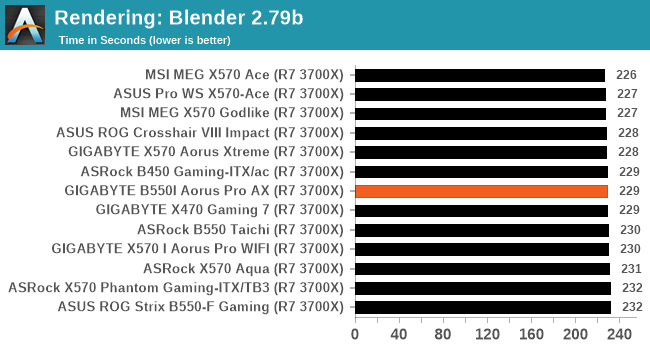
Streaming and Archival Video Transcoding - Handbrake 1.1.0
A popular open source tool, Handbrake is the anything-to-anything video conversion software that a number of people use as a reference point. The danger is always on version numbers and optimization, for example the latest versions of the software can take advantage of AVX-512 and OpenCL to accelerate certain types of transcoding and algorithms. The version we use here is a pure CPU play, with common transcoding variations.
We have split Handbrake up into several tests, using a Logitech C920 1080p60 native webcam recording (essentially a streamer recording), and convert them into two types of streaming formats and one for archival. The output settings used are:
- 720p60 at 6000 kbps constant bit rate, fast setting, high profile
- 1080p60 at 3500 kbps constant bit rate, faster setting, main profile
- 1080p60 HEVC at 3500 kbps variable bit rate, fast setting, main profile
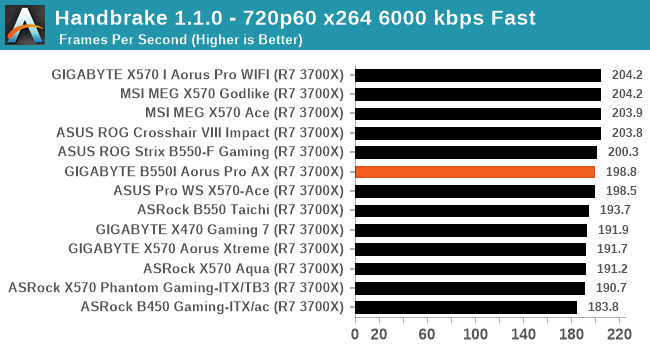
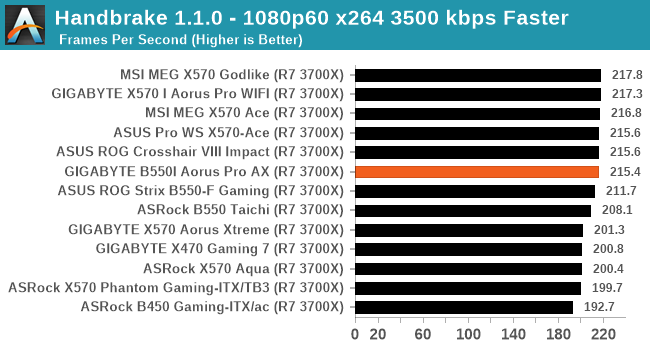
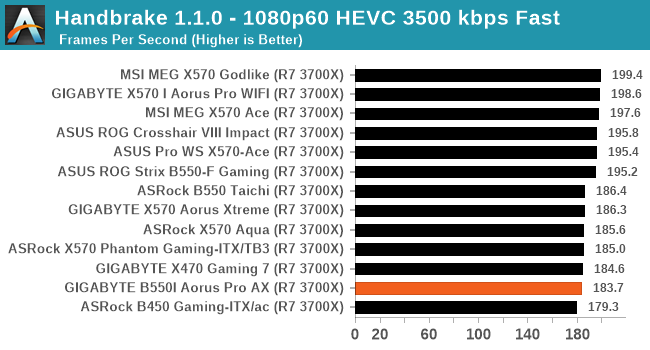
Rendering – POV-Ray 3.7.1: Ray Tracing - link
The Persistence of Vision Ray Tracer, or POV-Ray, is a freeware package for as the name suggests, ray tracing. It is a pure renderer, rather than modeling software, but the latest beta version contains a handy benchmark for stressing all processing threads on a platform. We have been using this test in motherboard reviews to test memory stability at various CPU speeds to good effect – if it passes the test, the IMC in the CPU is stable for a given CPU speed. As a CPU test, it runs for approximately 1-2 minutes on high-end platforms.
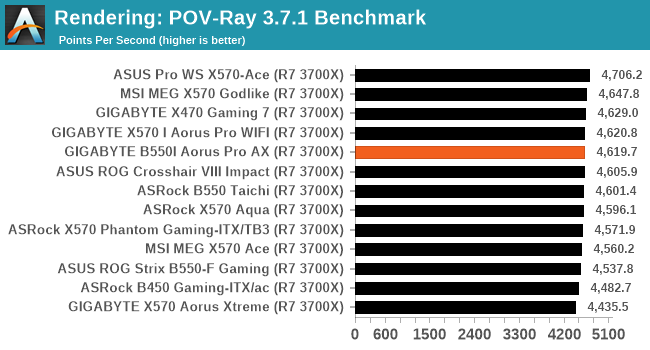
Compression – WinRAR 5.60b3: link
Our WinRAR test from 2013 is updated to the latest version of WinRAR at the start of 2014. We compress a set of 2867 files across 320 folders totaling 1.52 GB in size – 95% of these files are small typical website files, and the rest (90% of the size) are small 30-second 720p videos.
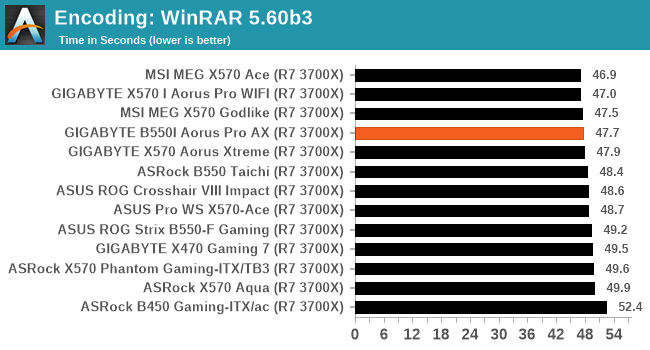
Synthetic – 7-Zip v1805: link
Out of our compression/decompression tool tests, 7-zip is the most requested and comes with a built-in benchmark. For our test suite, we’ve pulled the latest version of the software and we run the benchmark from the command line, reporting the compression, decompression, and a combined score.
It is noted in this benchmark that the latest multi-die processors have very bi-modal performance between compression and decompression, performing well in one and badly in the other. There are also discussions around how the Windows Scheduler is implementing every thread. As we get more results, it will be interesting to see how this plays out.


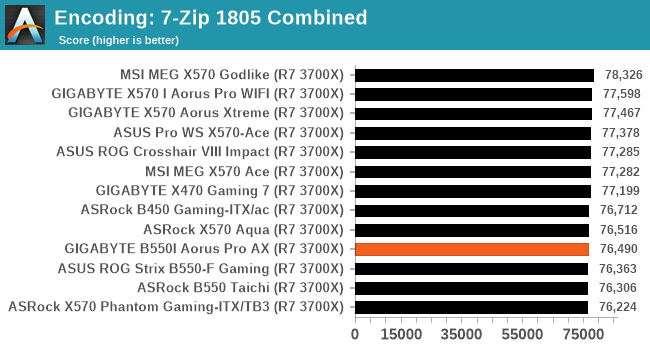
Point Calculations – 3D Movement Algorithm Test: link
3DPM is a self-penned benchmark, taking basic 3D movement algorithms used in Brownian Motion simulations and testing them for speed. High floating point performance, MHz, and IPC win in the single thread version, whereas the multithread version has to handle the threads and loves more cores. For a brief explanation of the platform agnostic coding behind this benchmark, see my forum post here.











76 Comments
View All Comments
romrunning - Monday, December 7, 2020 - link
This board has been out for quite a while, and it's been proven to be a good buy. If you done any homework at all on mini-ITX B550 boards, you'll know it's one of the top ones.The main difference between this board and the other top competitors is that it doesn't have a Type-C front-panel port. That seems to be the main reason why it's a bit cheaper than the other boards. I can see Gigabyte adding it in a "v2" of the board, though. If your choice for a new mini-ITX case has that style of port available, it may factor into your decision.
gavbon - Monday, December 7, 2020 - link
Of course, I agree with you. It's why it's been highlighted as my go-to Mini-ITX model in our AMD motherboard guides.romrunning - Monday, December 7, 2020 - link
What's annoying is that we can get these great mini-ITX boards back in stock, but the rest of the new components are out of stock. My NR200 & this Gigabyte board was going to be the base of a new build, but everything else is not available. I'm not going to buy from over-priced eBay offers, so for now, patience is the key.Zagreus86 - Monday, December 7, 2020 - link
I'm in the same boat, except I have everything except the case at this point (NR200). Seems we can't get them into the UK for love nor money at the moment!Questor - Wednesday, December 9, 2020 - link
Where is my Ryzen 5900X? I swear it was right here just a minute ago. Did you see it?christinescoms - Saturday, December 12, 2020 - link
I get paid more than 120 to 130 per hour for working online. I heard about this job 3 months ago and after joining this i have earned easily 15k from this without having online working skills. This is what I do.....___bit.ly/googlework75calc76 - Monday, December 7, 2020 - link
Another big difference is how many high speed ports the Asus B550-I has vs the Gigabyte B550I has, not just the lack of front 10Gbps Type C. Gigabyte probably skimped to be cheaper there as well:Asus B550-I:
5 10Gbps
2 5Gbps
4 480Mbps
Gigabyte B550I:
2 10Gbps
6 5Gbps
2 480Mbps
mkarwin - Tuesday, December 15, 2020 - link
And another is how the "supreme surround sound" is done through analog outputs - Asus requires connecting 2 rear ports and front-panel line-out for 5.1 analog speakers, while Gigabyte utilises rear ports only...Quad5Ny - Friday, March 26, 2021 - link
When you see ONLY 3 audio ports on the rear these days its usually auto-switching. So you'll get 5.1 using the back panel and 7.1 if you use the back and front panel. -Skip the mic and line-in on the rear and consult your MB manual.ozark - Tuesday, December 8, 2020 - link
For this exact reason I op'ed for the MSI MPG B550I, which is listed for $200 but often on sale for $185 or lower on Amazon. When you are on an ITX build, every port is precious and a front panel USB-C port is immensely useful. It's bit a of shame that the MSI board uses slightly inferior setup for their audio or wifi solution, although for most people there's no detectable difference.